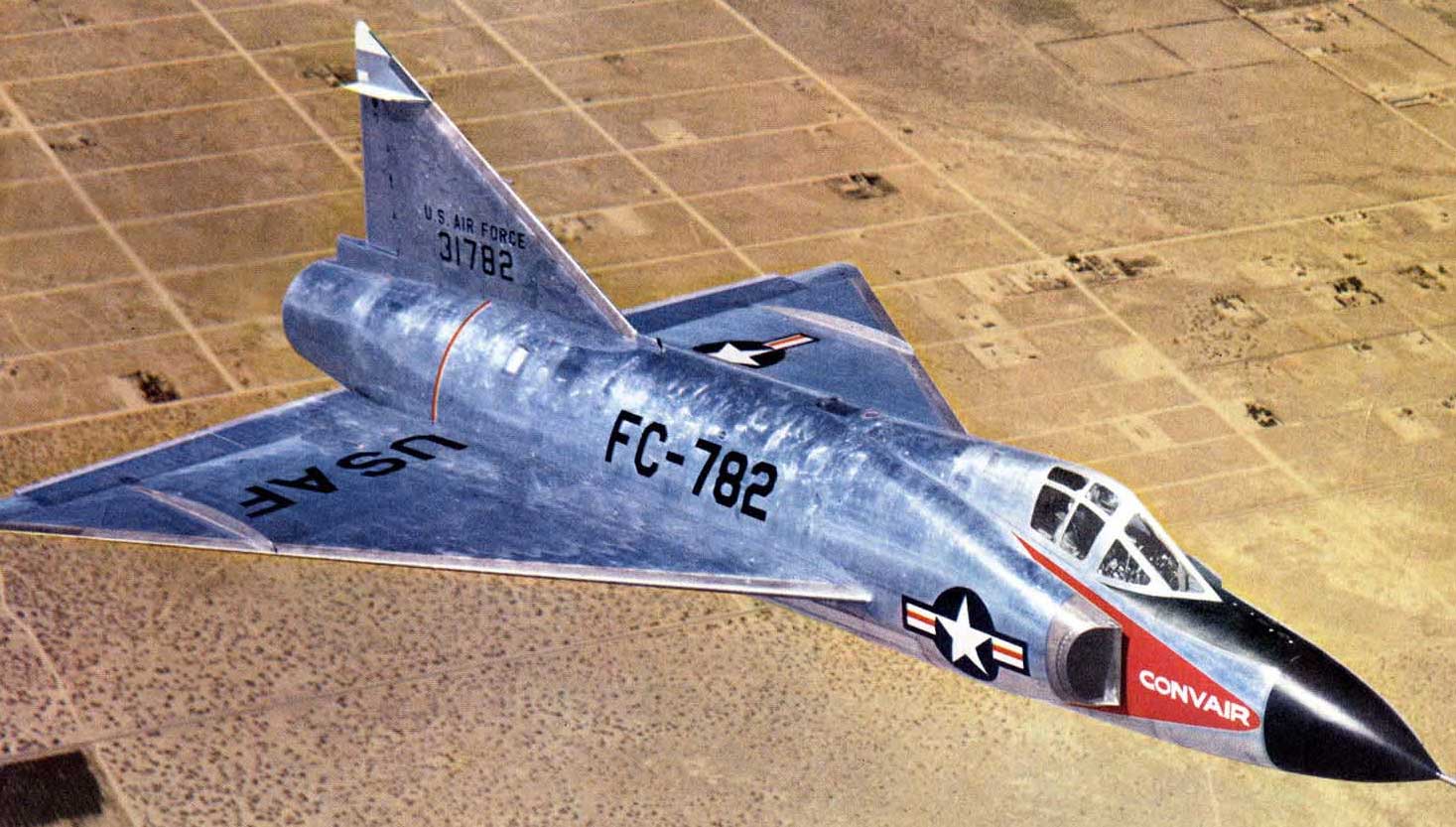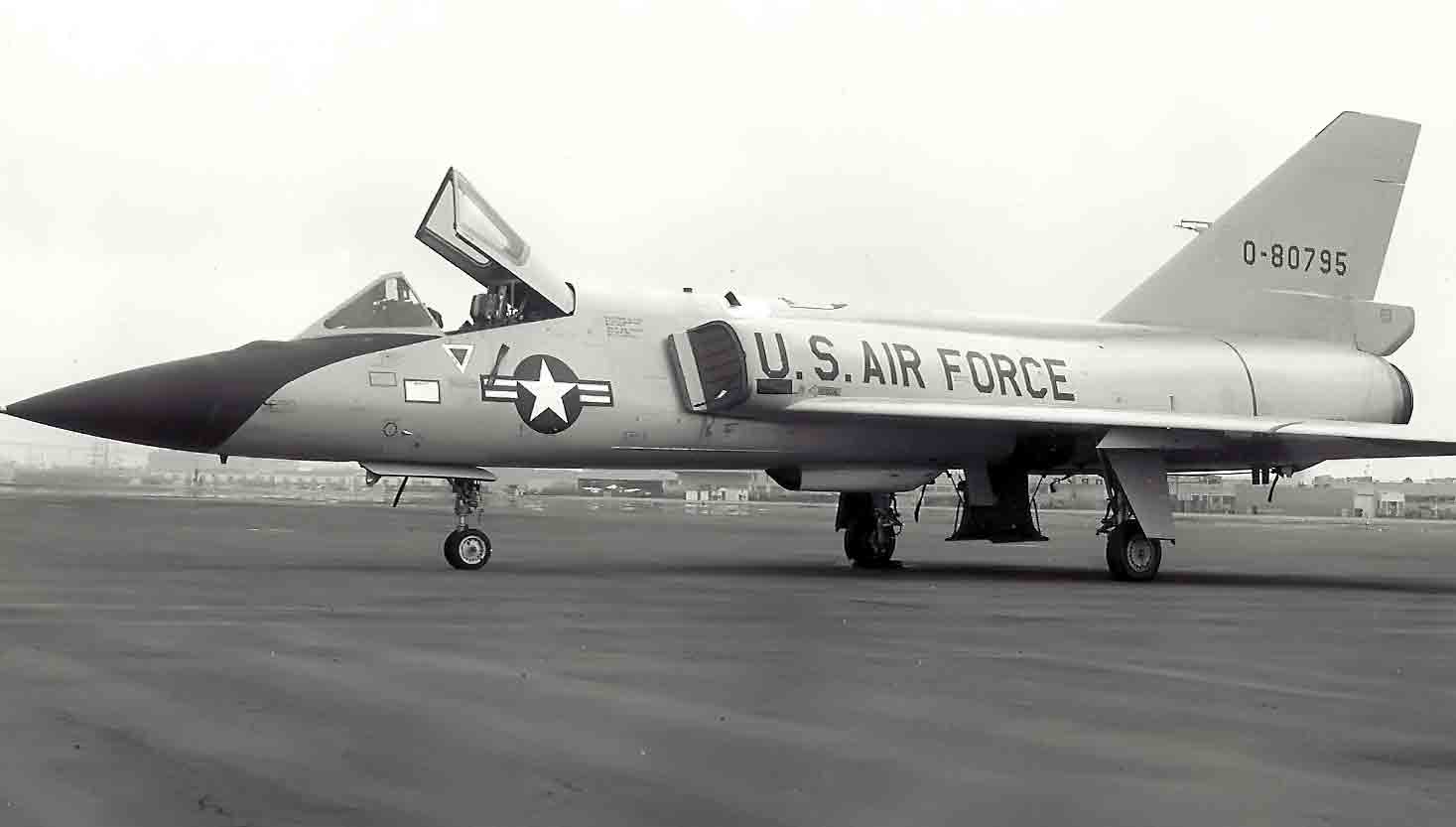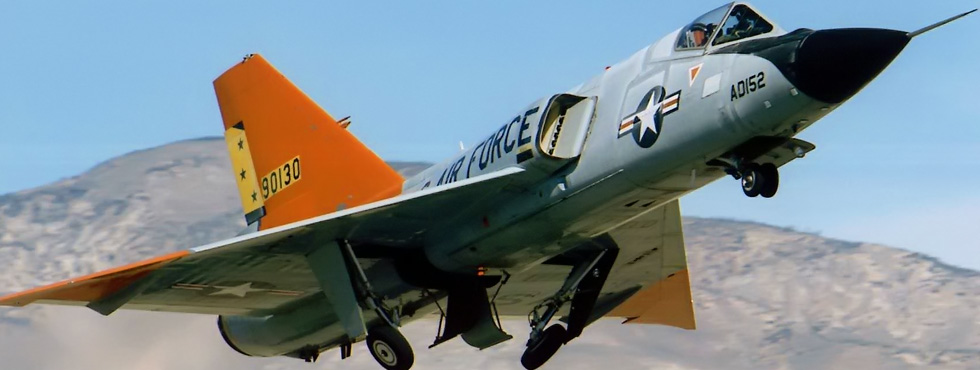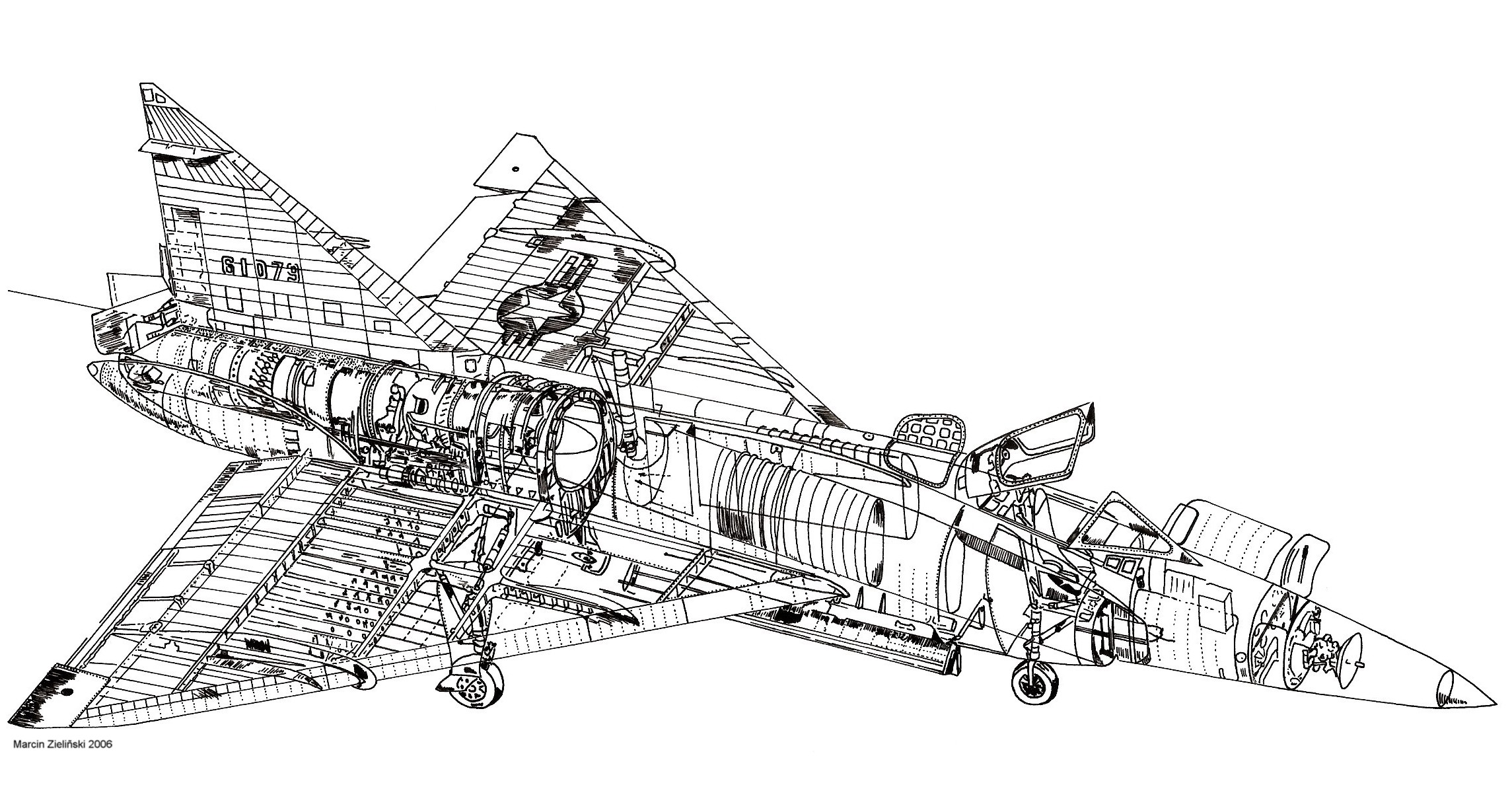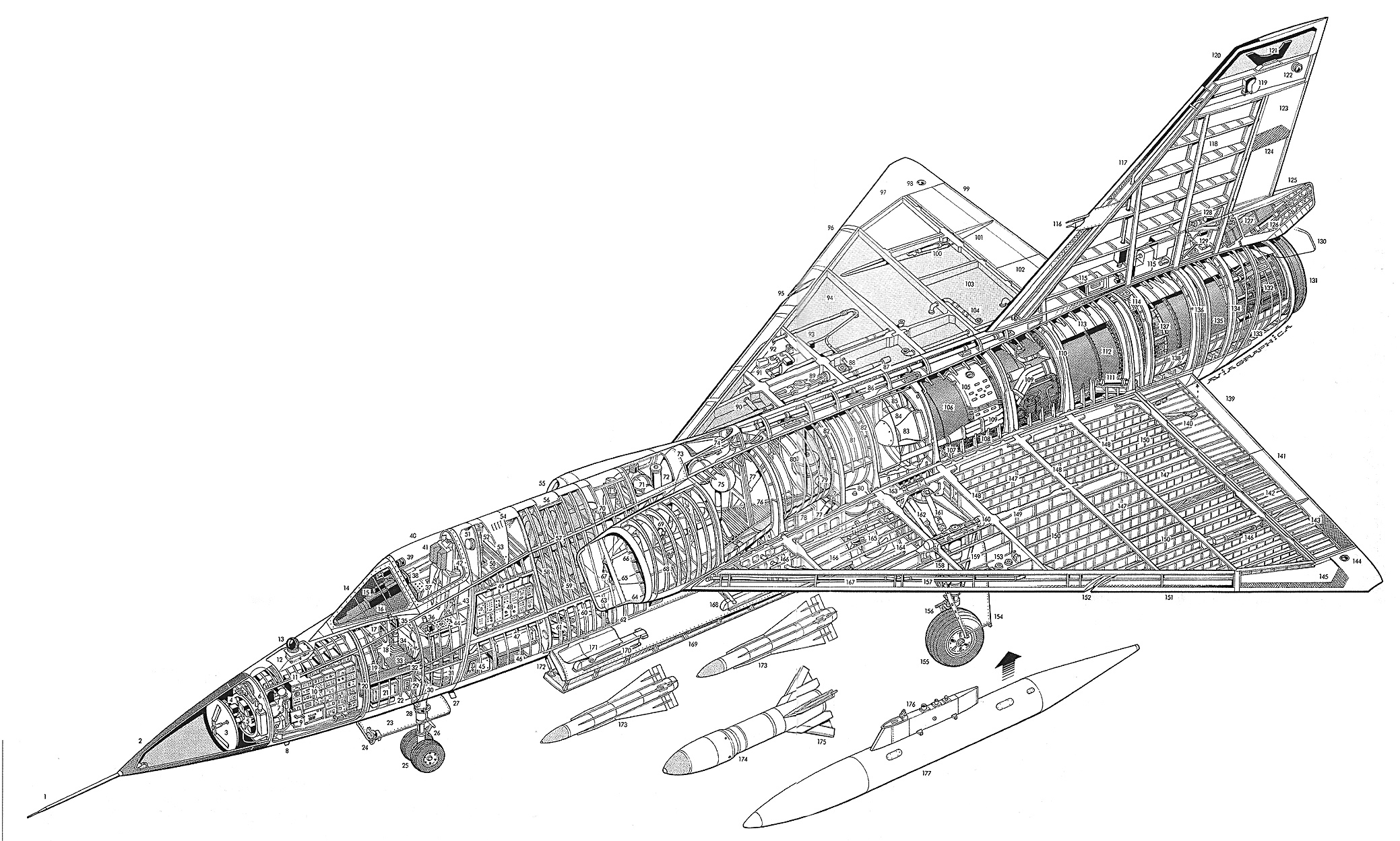Price: $24.95
- 7 magazines, 5 manuals, & photos
- PDF contains 1,514 pages
- Content is keyword searchable
- Print a personal copy
- Pay via PayPal or Credit Card
- International orders welcome!
- Download files upon payment
June 1981
- Convair F-106 Delta Dart
- Farewell to the Air Defense Command and manned interceptor
June 1984
- The F-106 bows out
- Grumman’s F-11F, the reluctant tiger
- DC-3/C-47 in foreign service
October 1987
- Last F-106 Delta Darts go to the boneyard
- Convair’s XP-81 push-pull fighter
- Bell’s P-59A Airacomet
May 1988
- Air Defense Command Expose
- History of Military Air-to-Air Refueling
February 1991
- F-102 air defense in Vietnam
- Air superiority in the Gulf
- Testing the first supersonic aircraft
October 2005
- Good, Better, Best – How aircraft designs evolve
- Miami Clippers, PanAm’s first seaplane base
- Lockheed C-141 Starlifter
December 2005
- F-106, USAF Colonel Jack Broughton’s favorite aircraft
- Top 10 Best USAF Planes
- “Hun Heaven”, A look back at the F-100
- Hughes XF-11 vs. Republic XF-12
Manuals & Photos
- F-102A Flight Training Manual, 1956
- F-106A/B Flight Manual, 1980
- F-106A/B Performance Data, 1972
- F-106A/B Technical Manual, 1961
- F-106A/B Pilot’s Checklist, 1974
- Over 1200 F-102 & F-106 photos!
Convair F-102 Delta Dagger / F-106 Delta Dart
F-102 Specs
F-106 Specs
Sky Scorcher
General Characteristics

- Crew: 1
- Length: 68 ft 4 in (20.83 m)
- Wingspan: 38 ft 1 in (11.61 m)
- Height: 21 ft 2 in (6.45 m)
- Wing area: 661.5ft²/61.52m² (Original Wing) or 695 ft²/64.57m² (Conically-Cambered Wing) ()
- Airfoil: NACA 0004-65 mod root and tip
- Empty weight: 19,350 lb (8,777 kg)
- Loaded weight: 24,500 lb (11,100 kg)
- Max. takeoff weight: 31,500 lb (14,300 kg)
- Powerplant: 1 × Pratt & Whitney J57-P-25 afterburning turbojet
- Dry thrust: 11,700 lbf (52.0 kN)
- Thrust with afterburner: 17,200 lbf (76.5 kN)
- Internal fuel capacity: 1,085 U.S. gal (4,107 l)
- External fuel capacity: 2 × 215 U.S. gal (815 l) drop tanks
Performance
- Maximum speed: Mach 1.25 (825 mph, 1,304 km/h) at 40,000 ft (12,190 m)
- Range: 1,350 mi (1,170 nmo, 2,175 km)
- Service ceiling: 53,400 ft (16,300 m)
- Rate of climb: 13,000 ft/min (66 m/s)
- Wing loading: 35 lb/ft² (172 kg/m²)
- Thrust/weight: 0.70
Rockets
- 24 × 2.75 in (70 mm) FFAR (Folding Fin Aerial Rocket) unguided rockets in missile bay doors
Missiles
- 6 × AIM-4 Falcon air-to-air missiles or
- 3 × AIM-4 Falcon
- 1 × AIM-26 Falcon with conventional or nuclear warhead
Avionics
- MG-10 fire control system
F-102 Variants
- YF-102 – Prototypes. Non area-ruled fuselage. Powered by 14,500 lbf (64.5 kN) J57-P-11, two built.
- YF-102A – Area-ruled prototypes. Powered by 16,000 lbf (71.2 kN) J57-P-23. Four converted from pre-production aircraft.
- F-102A – Production Model. Initial eight pre-production aircraft built with non-area ruled fuselage. Remainder built (879) with area ruled fuselage.
- TF-102A – Two-seat training version, 111 built.
- F-102B – The original designation of the F-106A.
- F-102C – Proposed tactical attack version with J57-P-47 engine. Two converted As as YF-102C engineering test beds.[38]
- QF-102A – Target drones converted from the F-102A. Six built.
- PQM-102A – Unpiloted target drones. 65 converted.
- PQM-102B – Revised target drone conversion, capable of being flown remotely or by pilot in cockpit. 146 converted.
F-102 On Display
Canada
F-102A
- 56-1266 – Stephenville, Newfoundland. This aircraft was formerly of the U.S. 59th Fighter Interceptor Squadron, Goose Bay (Happy Valley), Labrador.
Greece
F-102A
- 56-1106 – Tanagra.
- 56-1232 – Larisa.
TF-102A
- 56-2355 – Tatoi.
Netherlands
F-102A
- 56-1032 – Royal Netherlands Military Aviation Museum, Soesterberg Air Base.[46] Museum currently closed, reopening planned October 2014.
Turkey
F-102A
- 55-3386 – Turkish Air Force Aviation Museum, Yesilkoy, Istanbul.
TF-102A
- 56-2368 – Turkish Air Force Aviation Museum, Yesilkoy, Istanbul.
United States
YF-102A
- 53-1787 – Air Park at Jackson Barracks Military Museum, New Orleans, Louisiana
- 53-1788 – Carolinas Aviation Museum, Charlotte, North Carolina.
TF-102A
- 54-1353 – Century Circle at Edwards Air Force Base, near Rosamond, California
- 54-1366 – Pima Air and Space Museum adjacent to Davis-Monthan AFB in Tucson, Arizona.
- 56-2317 – Grissom Air Museum, Grissom Air Reserve Base (former Grissom AFB), Peru, Indiana.
- 56-2337 – Fort Worth Aviation Museum, Fort Worth, Texas.
- 56-2346 – Pennsylvania National Guard Military Museum, Pennsylvania National Guard Headquarters, Fort Indiantown Gap, Pennsylvania. (Aircraft was assigned to the Pennsylvania Air National Guard, at the 112th Fighter Interceptor Group, Pittsburgh International Airport, Coraopolis, Pennsylvania from 1960–1974 and is on loan from the National Museum of the United States Air Force).
- 56-2352 – Southern Museum of Flight, Birmingham, Alabama.
F-102A
- 54-1405 – Strategic Air and Space Museum, Ashland, Nebraska near Offutt AFB, Nebraska
- 55-3432 – Hector Field, Fargo, North Dakota
- 56-0984 – Wings Over the Rockies Museum, (former Lowry AFB) Denver, Colorado.
- 56-0985 – McEntire Air National Guard Base, South Carolina
- 56-0986 – MAPS Air Museum, Akron-Canton Regional Airport, Ohio.
- 56-1053, (painted as 56-1274), – Elmendorf AFB, Alaska Heritage Park.
- 56-1105 – Lions Park in Great Falls, Montana.
- 56-1109 – Peterson Air and Space Museum, Peterson AFB, Colorado Springs, Colorado.
- 56-1114 – March Field Air Museum, March ARB (former March AFB), Riverside, California.
- 56-1140 – Aerospace Museum of California, former McClellan AFB, Sacramento, California.
- 56-1151 – Museum of Aviation, Robins AFB, Warner Robins, Georgia.
- 56-1219 – Empire State Aerosciences Museum, Schenectady County Airport, New York.
- 56-1268 – San Diego Air and Space Museum, Gillespie Field, El Cajon, California.
- 56-1357 – 125th Fighter Wing Memorial Air Park, Jacksonville Air National Guard Base, Jacksonville International Airport, Florida.
- 56-1368 – Evergreen Aviation Museum, McMinnville, Oregon.
- 56-1393 – Pima Air and Space Museum adjacent to Davis-Monthan AFB in Tucson, Arizona.
- 56-1413 – Castle Air Museum (former Castle AFB), Atwater, California.
- 56-1415 – Pittsburgh IAP Air Reserve Station (located at Pittsburgh International Airport). Refurbished in 2010
- 56-1416 – National Museum of the United States Air Force, Wright-Patterson Air Force Base near Dayton, Ohio
- 56-1325, (painted as 56-1476), – Minnesota Air National Guard Base, Minneapolis, Minnesota
- 56-1515 – McChord Air Museum, McChord Air Force Base, Washington.
- 57-0833 – Hill Aerospace Museum, Hill AFB, Utah.
- 57-0858 – Tyndall Air Park, Tyndall AFB, Florida.
- 57-788 – Long Island MacArthur Airport, Long Island.
F-102 Cutaway
General Characteristics
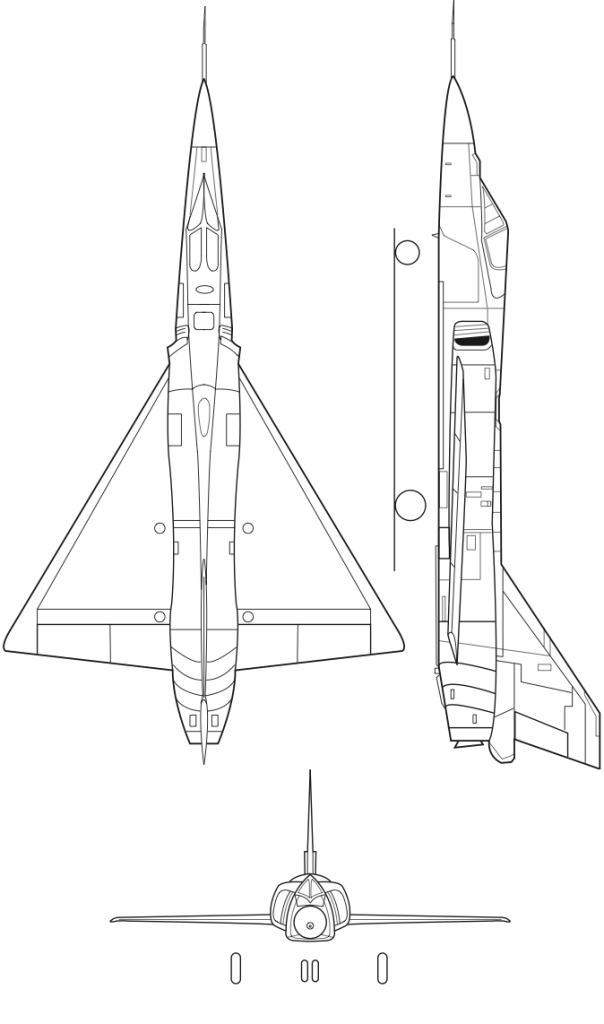
- Crew: 1
- Length: 70.7 ft (21.55 m)
- Wingspan: 38.25 ft (11.67 m)
- Height: 20.28 ft (6.18 m)
- Wing area: 661.5ft²/61.52m² (Original Wing) or 695 ft²/64.57m² (Conically-Cambered Wing) ()
- Airfoil: NACA 0004-65 mod root and tip
- Empty weight: 24,420 lb (11,077 kg)
- Loaded weight: 34,510 lb (15,670 kg)
- Powerplant: 1 × Pratt & Whitney J75-17 afterburning turbojet, 24,500 lbf (109 kN)
- * Zero-lift drag coefficient: 0.0083
- Drag area: 5.8 ft² (0.54 m²)
- Aspect ratio: 2.10
Performance
- Maximum speed: Mach 2.3 (1,525 mph, 2,455 km/h)
- Range: 1,800 mi (1,600 nm, 2,900 km) combat
- Ferry range: 2,700 mi (2,300 nm, 4,300 km)
- Service ceiling: 57,000 ft (17,000 m)
- Rate of climb: 29,000 ft/min (150 m/s)
- Wing loading: 52 lb/ft² (255 kg/m²)
- Thrust/weight: 0.71
- Lift-to-drag ratio: 12.1
- Time to altitude: 6.9 min to 52,700 ft (16,065 m)
Guns
- 1 20 mm caliber M61 Vulcan 6-barreled rotary cannon (After 1972 refit)
Missiles
- 2 AIM-4F Falcon
- 2 AIM-4G Falcon
- 1 AIR-2A Genie nuclear rocket or AIM-26 Super Falcon missile (Prior to 1972 refit)
F-106 Variants
- F-102B : The original designation of the F-106A.
- F-106A : (Convair Model 8-24) Improved version of the F-102. Fitted with the MA-1 Integrated Fire Control System with SAGE datalink, J-75 afterburning turbojet, enlarged intake, variable-geometry inlet ramps and shortened intake ducts, refined fuselage shape, modified wings and redesigned tailfin; tailpipe fitted with a device to reduce the tendency of the jet exhaust to blow unsecured objects around while taxiing, yet allowing virtually maximum performance at high thrust settings including afterburner. Performance was deemed unsatisfactory and modifications were made. The aircraft was capable of low supersonic speeds without afterburner (but with a significant range penalty) and had a maximum altitude at least 57,000 ft. Many were fitted with a conically-cambered wing for improved takeoff, supersonic and high-altitude flight. To improve the aircraft’s range the aircraft was fitted with two streamlined external supersonic tanks that still kept the aircraft capable of sustained roll rates of 100 degrees per second. Since these tanks produced virtually no significant performance degradation they were rarely jettisoned and were routinely carried around. After 1972, many F-106s were refitted with a new canopy featuring improved visibility, improved optic sights and provision for a gunpack in the center weapons bay.
- F-106B : (Convair Model 8-27) Two-seat, combat-capable training version. Pilot and instructor are seated in tandem. Due to the extra seat, the fuselage is actually better area ruled; combined with a likely reduction in weight. Weapons configurations same as F-106A.
- NF-106B : This designation was given to two F-106Bs used as test aircraft with NASA and associated research facilities from 1966 to 1991.
- F-106C : Unbuilt version. Aircraft was intended to have the AN/ASG-18 radar and fire control system fitted originally developed for the North American XF-108 Rapier. For its time, it was the largest radar to ever be fitted to a fighter, actually requiring hydraulic actuators to turn the antenna. To accommodate this larger radar system, the nose cone was longer and of greater diameter. The design featured an improved raised canopy design featuring better visibility, canards and lengthened rectangular inlet ducts. The aircraft was to be capable of carrying one GAR-9/AIM-47A in its center bay and one AIM-26A in each side bay. At one time, the US Air Force had considered acquiring 350 of these advanced interceptors, but the F-106C/D project was cancelled on 23 September 1958.
- F-106D : Unbuilt two-seat version of the F-106C.
- F-106X : Unbuilt version (early 1968). It would have been outfitted with canards and powered by a JT4B-22 turbojet. It was envisioned as an alternative to the Lockheed YF-12, and was to have had a fire control system with “look-down, shoot-down” capability fed by a 40-inch radar dish.
- F-106E : Unbuilt version. On 3 September 1968, Convair issued a proposal for an “improved” interceptor that was to be designated F-106E/F. It was to be compatible with the upcoming airborne warning and control systems as well as with the “over-the-horizon” radar defense network. The F-106E/F would have had a longer nose and a new and improved radar with a look-down/shoot-down tracking and missile launch capability. It would also have had a two-way UHF voice and datalink radio. It would have been capable of launching both nuclear and non-nuclear missiles, including the AIM-26 Nuclear Falcon and the AIM-47.
- F-106F : Unbuilt two seat version of the F-106E.
- QF-106A : Converted into drones, were still capable of being flown both as manned and unmanned aircraft.
- F-106 RASCAL Project : Unbuilt version. It would have been a low cost satellite launcher.
F-106 On Display
F-106A
- 56-0454 – Holloman AFB, New Mexico.
- 56-0459 – McChord Air Museum, McChord AFB, Washington.
- 56-0460 – Minot AFB, North Dakota.
- 56-0461 – former K. I. Sawyer Air Force Base, Michigan.
- 57-0230 – Jacksonville Air National Guard Base at Jacksonville International Airport, Florida.
- 58-0774 – Hill Aerospace Museum, Hill AFB, Utah.
- 58-0787 – National Museum of the United States Air Force, Wright-Patterson AFB, Dayton, Ohio. Nicknamed the “Cornfield Bomber,” this F-106 landed itself with relatively minor damage in a farmer’s field after its pilot lost control and ejected. It last served with the 49th Fighter Squadron before being brought to the museum in August 1986.
- 58-0793 – Castle Air Museum at the former Castle AFB, Atwater, California.
- 59-0003 – Pima Air & Space Museum, adjacent to Davis-Monthan AFB in Tucson, Arizona.
- 59-0010 – Aerospace Museum of California, McClellan Airfield (former McClellan AFB), Sacramento, California.
- 59-0023 – Air Mobility Command Museum, Dover AFB, Delaware.
- 59-0043 – AMARC, Davis-Monthan AFB, Arizona.
- 59-0069 – Great Falls Air National Guard Base, Great Falls Airport, Montana.
- 59-0086 – Pacific Coast Air Museum, Santa Rosa, California.
- 59-0105 – Camp Blanding Museum, Camp Blanding Florida National Guard Joint Training Center, Middleburg, Florida.
- 59-0123 – Museum of Aviation, Robins AFB, Warner Robins, Georgia.
- 59-0134 – Peterson Air and Space Museum, Peterson AFB, Colorado Springs, Colorado.
- 59-0137 – Evergreen Aviation & Space Museum, McMinnville, Oregon.
- 59-0145 – Tyndall Air Park, Tyndall AFB, Florida.
NF-106A
- 56-0451 – Selfridge Military Air Museum, Selfridge Air National Guard Base, Michigan.
F-106B
- 57-2513 – Yanks Air Museum, Chino, California.
- 57-2523 – Atlantic City Air National Guard Base, Atlantic City, New Jersey.
- 57-2533 – Kelly Field Heritage Museum, Lackland AFB/Kelly Field (former Kelly AFB), Texas.
- 59-0146 – Fresno Air National Guard Base at Fresno Yosemite International Airport, California.
- 59-0158 – Edwards AFB Century Circle, Edwards AFB, California.
NF-106B
- 57-2516 – Virginia Air and Space Center / Hampton History Center, Hampton, Virginia.
F-106 Cutaway
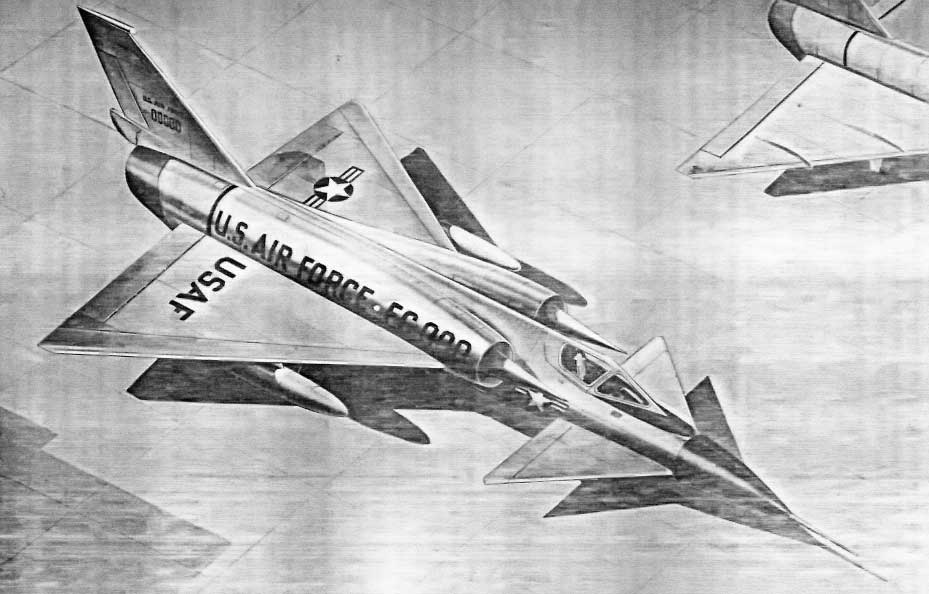
Sky Scorcher was an nuclear-armed air-to-air missile proposed to the United States Air Force in the 1950s.
Intended for use as a weapon for the disruption of enemy bomber formations, it failed to find favor among Air Force planners and did not undergo development. The Sky Scorcher project was proposed by the Convair Division of General Dynamics to the United States Air Force in 1956. The missile was intended to be carried by an advanced, enlarged version of Convair’s F-106 Delta Dart interceptor, which had, at the time, not yet entered flight testing even in its baseline form.
Sky Scorcher was a very large missile, which was projected to be capable of carrying a thermonuclear warhead with a yield of two megatons. The oversized warhead would be used against attacking formations of supersonic bombers; it was anticipated that fourteen such initiations, at a distance of approximately 460 miles (740 km) from the bombers’ target, would be sufficient to disrupt an attack.
A force of eighty of the advanced fighters were proposed for carrying the weapon. Despite Convair’s sales pitch and the anticipated effectiveness of the weapon, the Air Force was unenthusiastic about the concept; aside from the expense of developing the aircraft and weapon, the Sky Scorcher missile also suffered from the fact that there would be significant effects on the ground below the location of an airburst of a multi-megaton nuclear warhead. As a result, the project was abandoned before any significant work was undertaken.
- Designed: 1956
- Manufacturer: Convair
- Number built: 0
- Weight: 3,400 pounds (1,500 kg)
- Length: 18 feet (5.5 m)
- Diameter: 18 inches (460 mm)
- Warhead: Thermonuclear
- Blast yield: 2 megatons of TNT (8.4 PJ)
- Operational range: 140 mi (230 km)
- Speed: Mach 3+




